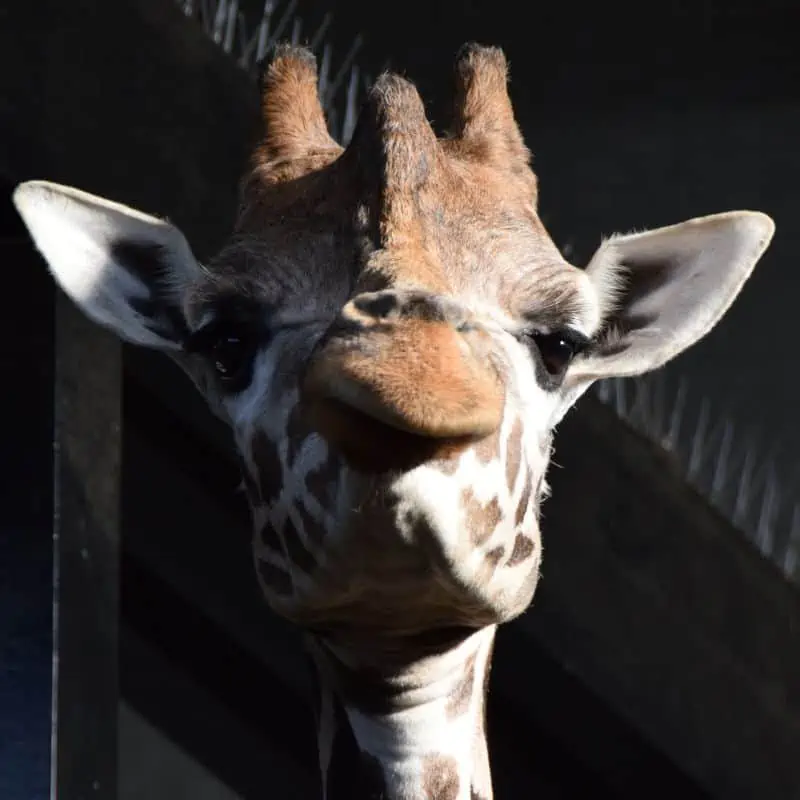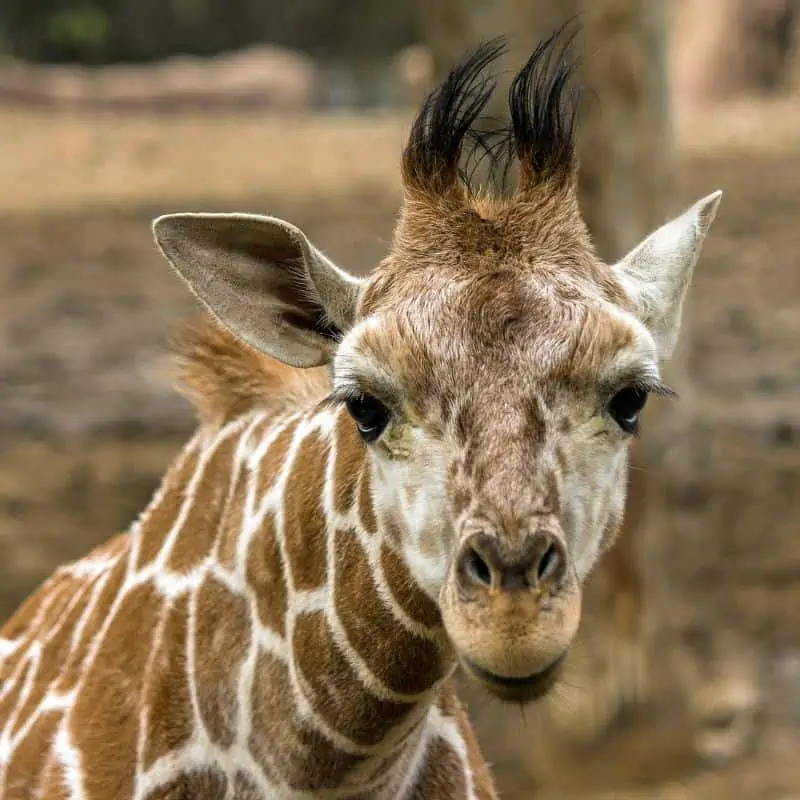Reticulated giraffes are one of the most recognizable animals in Africa. These gentle giants can reach over 18 feet tall and weigh over 4,000 pounds.
Here are ten interesting facts about reticulated giraffes that you may not know.

- 1. They Have The Neatest Looking Coat Pattern
- 2. Everything About The Reticulated Giraffe Is Larger Than Life
- 3. They Are Constantly Eating
- 4. They Only Sleep For 30 Minutes At A Time
- 5. The Reticulated Giraffe Is Endangered
- 6. Most Common Giraffe In Captivity
- 7. Has Become a Catalyst For Change
- 8. Has Often Been Interbred With The Rothschild’s Giraffe
- 9. Has A Blood Pressure That’s Lethal For Humans
- 10. Reticulated Giraffes Could Be The Cure For Hypertension
- Final Thoughts On The Reticulated Giraffe
- FAQs
1. They Have The Neatest Looking Coat Pattern
The reticulated giraffe has the neatest-looking coat pattern of all the giraffe species.
They have large geometric-shaped spots that contrast against the bright white line giving it a reticulated look.
The spots can range from a soft brown to orange and deep red. Even from a distance, it is hard to miss a reticulated giraffe.
2. Everything About The Reticulated Giraffe Is Larger Than Life
We all know that the giraffe is a tall animal. But along with that height is a massive weight that can reach up to 4,200 lb (1,900 kg).
Reticulated giraffes have hearts weighing up to 22 lb (10 kg). And if you ever have one come close to you, you’ll instantly notice its long, prehensile tongue that can measure almost half a meter.
Their legs are about as tall as a regular NBA player at 6’6” with an equally long neck. It is not unusual to see a giraffe that’s 15 feet tall. They max out at around 18 feet with the tallest giraffe, Forest, standing at 18’6”.
3. They Are Constantly Eating
Having such a large body requires large amounts of food. Thus, the giraffe has to constantly be on the move, grazing from one tree to another.
Areas where giraffes stay often feature neatly trimmed treetops, and now you know why.

4. They Only Sleep For 30 Minutes At A Time
Like other giraffes, Reticulated Giraffes barely sleep.
30 minutes is more than enough for a giraffe to recover enough energy to continue munching on Acacia leaves for the rest of the day.
They also do their sleeping standing up, which is probably why they are such light sleepers.
They only tend to lie down for sleep when in captivity or when other giraffes are around to keep watch.
5. The Reticulated Giraffe Is Endangered
There are less than 9,000 reticulated giraffes in the wild. This number continues to dwindle as natural predators, poachers, habitat loss, climate change, and other factors remain present in the giraffe’s domain.
There is an active cause to keep giraffes from eventually dying out carried out by zoos and other private organizations.
6. Most Common Giraffe In Captivity
Despite its endangered status, the reticulated giraffe is the most common in zoos worldwide.
Therefore, it serves as an ambassador for its kind, raising awareness for its plight in the wild and giving joy to zoo visitors worldwide who get to see a giraffe for the first time.

7. Has Become a Catalyst For Change
The reticulated giraffe has brought about positive change for giraffes worldwide. Regardless of species, all giraffes fall under one umbrella, as not many realize these animals have four different species.
As that is the case, the reticulated giraffe represents everyone within that scope.
The reticulated giraffe has brought to the fore the plight of giraffes. Once numerous throughout Africa, a dismal number of giraffes remain in the wild today.
This severe reduction in their population greatly impacts the giraffe’s ability to survive a few more generations.
8. Has Often Been Interbred With The Rothschild’s Giraffe
As a result of wrong assumptions, the reticulated giraffe has often been mated with Rothschild giraffes. This can affect the distinct qualities between the two.
Luckily, this oversight has been noted, and conservationists now keep Rothschild giraffes and Reticulated giraffes separated when it comes to mating.
9. Has A Blood Pressure That’s Lethal For Humans
Having such a tall stature isn’t all it’s cut out to be. There are some special physical conditions that you have to address. For the reticulated giraffe, its blood circulation needs special care.
Giraffes have a highly developed cardiovascular system that allows their heart to pump enough blood to their brain and body.
At rest, the reticulated giraffe’s heart beats 70 times per minute, which sounds fairly normal until we look at their blood pressure; 220/180.
10. Reticulated Giraffes Could Be The Cure For Hypertension
Reticulated giraffes have to lower their necks to drink. Because of their high blood pressure, they risk causing too much blood pressure in their brain.
Thankfully, their bodies have adapted well to their high blood pressure.
When lowering their heads, the blood vessels in their head contract rapidly to reduce blood flow and excess pressure in the brain.
When raising their heads back up, blood is kept in the brain by special muscles surrounding their neck veins to prevent blood from rushing back to the heart.
This knowledge, if properly utilized, could help save millions of people who suffer from hypertension and other cardiovascular diseases.

Final Thoughts On The Reticulated Giraffe
Though often overshadowed by their more well-known African cousins, the spots of a giraffe are unique and serve as camouflage in their natural environment.
The reticulated giraffe is the most common type of giraffe in captivity – you might have seen one at your local zoo.
However, they are endangered in the wild due largely to habitat loss and hunting.
Because of their high blood pressure, Giraffes could potentially help us treat hypertension if we can protect them.
FAQs
Why Are They Called Reticulated Giraffes?
Reticulated giraffes are named after their distinctive coats. The brown and white, brick-like pattern is known as a reticulated pattern, hence the name.
Are Giraffes Strictly Herbivorous?
Yes. Giraffes are strictly herbivorous and favor eating the leaves of Acacia trees. Their mouths are highly developed to withstand the thorns that serve as a natural defense feature of the trees. If no Acacias are found, giraffes can adapt to other trees or simply move on in search of more.
Are Giraffes Harmless To Humans?
No. It’s easy to fall under a false sense of security when you see a giraffe and not think it’s dangerous. A giraffe can easily kill a person with one kick of its powerful legs. For the most part, if left alone, a wild giraffe won’t go out of its way to harm a human.
